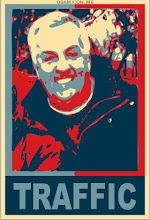
Janet Barlow of Accessible Design for the Blind offers guidance to Shelley Bruns of Littleton as she crosses a Golden roundabout. (Joe Amon, The Denver Post )
Boosting safety is studied in Golden, CO
By Jeffrey Leib The Denver Post
GOLDEN — With cameras filming discreetly from a distance, Shelley Bruns stops with her white cane at the roundabout crosswalk at Johnson and South Golden roads and listens to the traffic exiting the circle.
Many vehicles drive past her at the double-lane roundabout, but finally a car in the right lane stops, followed by one in the inside lane.
Recognizing the yield, Bruns walks in front of the cars to the island that separates traffic flowing in and out of the circle. There, she listens for vehicles to similarly yield, or for a gap in traffic, before she completes the crossing.
In recent weeks, Bruns and 15 other blind volunteers helped a national team of researchers study ways of improving the safety of blind pedestrians at traffic circles. The team has examined roundabout safety in other cities as well, including Nashville, Tenn.; Tampa, Fla.; and Raleigh, N.C. "I have taught orientation and mobility myself," said Bruns, who works for the Colorado Center for the Blind in Littleton. "But I never have dealt with a roundabout."
Many U.S. communities are installing roundabouts as a way to slow traffic and reduce auto accidents, yet they present special challenges for the blind, said Richard Long, a Western Michigan University professor of blindness and low-vision studies who is leading the $11.8 million research effort. The study is sponsored by the National Institutes of Health/National Eye Institute and National Academy of Engineering, a unit of the National Academies of Science.
At traditional intersections regulated by traffic signals or stop signs, blind pedestrians rely on audible cues offered by the predictable starting and stopping of traffic, Long said. Because modern roundabouts, by design, have a free flow of vehicles, blind pedestrians trying to cross them at designated crosswalks must listen carefully and judge when there is a safe gap in traffic or when vehicles have stopped and are yielding, Long said, as he watched Bruns at the Johnson Road roundabout, a research-team associate at her elbow.
The new generation of ultra-quiet hybrid vehicles adds even more challenges because they reduce the audible cues available to blind pedestrians. For the study, the associate, Janet Barlow of Accessible Design for the Blind, offers minimal guidance to the blind participants. "This is an exit-lane crossing; traffic is approaching from your left; cross when you are ready," she told Bruns during one film sequence. Barlow will stop Bruns if she makes a mistake. Researchers count the number of these "interventions" to assess an intersection's risk.
Posted signs at roundabout crosswalks tell drivers to yield to pedestrians.
"Some cars yield; some blow right by," Long said, noting that "double-lane roundabouts present a multiple threat" because the blind pedestrian must ensure that vehicles in both lanes have stopped and are yielding.
Film studies of those crossing at two roundabouts here are linked to testing new methods for improving safety. http://videocenter.denverpost.com/services/link/bcpid934052406/bctid1655754279
One test calls for Golden to install a crossing signal that pedestrians can activate to briefly stop traffic entering or exiting a roundabout. The signal clicks each second to alert blind pedestrians of its presence. By pushing a button, the pedestrian actuates a red stoplight to halt traffic and an audible message tells pedestrians the walk signal is on.
In the other, engineers will install a raised crosswalk to test the tendency of motorists to slow down and yield to blind pedestrians. "A driver's propensity to yield is directly related to speed," Long said.
The study team, which includes engineers from North Carolina State University's Institute for Transportation Research and Education, plans to reassemble in Golden in September to film the same volunteers crossing the roundabouts with the new technologies in place. "If these things work, they may be applied nationwide with the support of the U.S. Access Board," Long said, referring to the agency that develops regulations for the Americans With Disabilities Act.
After several hours of filming, Bruns assessed some of the challenges of crossing at roundabouts.
"I'd rather have a yield," she said. "But if I hear a gap, I'll go for it."



No comments:
Post a Comment